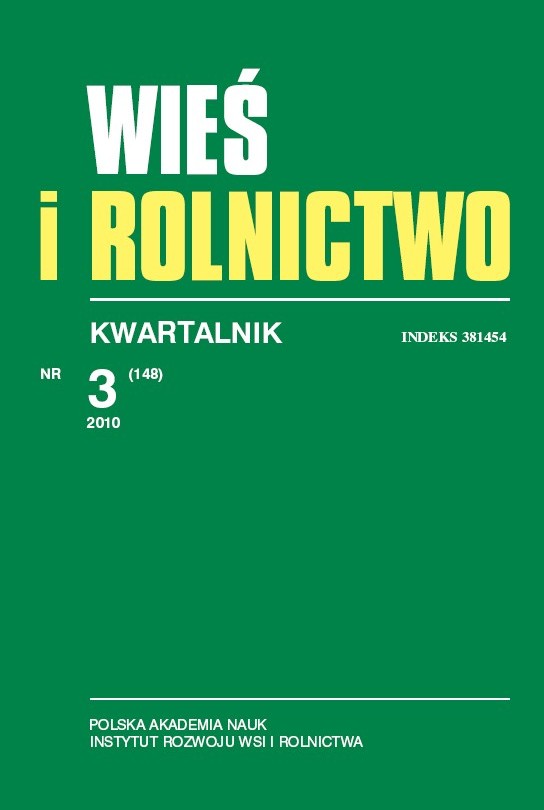The Structure of Output of Individual Farms in Poland and in the Countries of EU-27 – An Analysis of Similarities in 2007
DOI:
https://doi.org/10.53098/wir.2010.3.148/05Keywords:
structure of output, plant and animal production, similarity of structures, individual farmAbstract
The aim of the conducted research was to compare the structure of agricultural output of an average Polish individual farm with that of an average farm from the EU-27 countries. The FADN data for 2007 was used for the purpose of analysis. Descriptive and comparative analyses were applied, and also some selected descriptive statistical methods were used (intensity and structure indexes, measure of structure similarity, standardization of simple characteristics and hierarchical agglomeration classification). The comparison of the principal average results of Polish and EU farms showed that the value of the greater part of these categories was lower by about a half in the average Polish individual farm than in the average EU farm. In three rankings according to the absolute values of total output, of plant production and animal production, the average Polish farm placed at the bottom of the list of 26 other average EU farms. The results obtained with the help of the measure of structure similarity proved that the structure of total output of the average Polish farm was typical for the countries of Central and Northern Europe. Also the structure of plant production of the average Polish farm was similar to a considerable degree to that of British and German farms, while the structure of animal production resembled that of the average Hungarian farm. The conducted hierarchical agglomeration classification (according to the structure of output, ESU, total area under cultivation, output and income) permitted to include the average Polish individual farm to the class of medium-small farms from Central and Eastern Europe, which engage chiefly in the production of plants such as cereals, vegetables and flowers, but also in the production of milk and dairy goods, and in the production of pork meat.References
Chmielewska B., Mierosławska A., 2007: Krajowa czy regionalna strategia rozwoju rolnictwa i obszarów wiejskich? „Zagadnienia Ekonomiki Rolnej” 2.
FADN 2010 (www.europa.eu.int/comm/agriculture/rica/dwh – czerwiec 2010).
Kapusta F., 2007: Pozycja rolnictwa polskiego w UE-25. Roczniki Naukowe SERiA IX, 1.
Miś T., 2008: Oddziaływanie doradztwa na zmiany w gospodarstwach w aspekcie zwiększenia ich konkurencyjności. Roczniki Naukowe SERiA X, 1.
Pawlak K., Poczta W., 2007: Pozycja konkurencyjna polskiego sektora rolno-spożywczego na jednolitym rynku europejskim. „Wieś i Rolnictwo” 4. DOI: https://doi.org/10.53098/wir.2008.4.141/05
Poczta W., Czubak W., Pawlak K., 2009: Zmiany w wolumenie produkcji i dochodach rolniczych w warunkach akcesji Polski do UE. „Zagadnienia Ekonomiki Rolnej” 4.
Polskie rolnictwo na tle rolnictwa Unii Europejskiej, 2004. Fiszka informacyjna. CIE (www.rcie.lodz.pl; czerwiec 2010).
Uniwersalia polityki rolnej w gospodarce rynkowej, 2007. Red. A. Czyżewski. Wydawnictwo AE w Poznaniu, Poznań.
Walesiak M., 2004: Metody klasyfikacji. W: Metody statystycznej analizy wielowymiarowej w badaniach marketingowych. Red. E. Gatnar, M. Walesiak. Wydawnictwo Akademii Ekonomicznej im. O. Langego we Wrocławiu, Wrocław.
Wyniki standardowe uzyskane przez indywidualne gospodarstwa rolne prowadzące rachunkowość rolną w 2005 roku, 2006. IERiGŻ, Warszawa.
Wysocki F., Lira J., 2005: Statystyka opisowa. Wydawnictwo Akademii Rolniczej w Poznaniu, Poznań.
Downloads
Article file downloads
Pages
How to Cite
Issue
Section
License
Copyright (c) 2010 Wieś i Rolnictwo

This work is licensed under a Creative Commons Attribution 4.0 International License.










